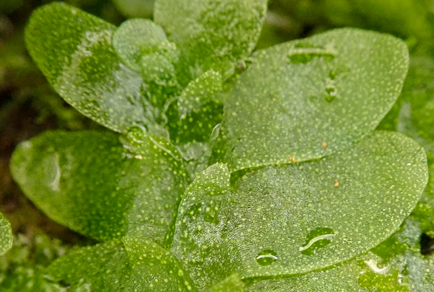Abstract
Treubia insignis, previously known for the Philippines from a single collection obtained in 1913, is rediscovered just over a century later, this time from the southern Philippines. Habitat preference, at least in the southern Philippines, is along riparian corridors of small streams in high-quality montane hardwood tropical rainforests.
Downloads
Download data is not yet available.
References
- Bakalin, V. & Vilnet, A. (2017) How many species are in Apotreubia S. Hatt. & Mizut. (Marchantiophyta)? Nova Hedwigia 104: 473–482. https://doi.org/10.1127/nova_hedwigia/2016/0386
- Campbell, D.H. (1916) The archegonium and sporophyte of Treubia insignis Goebel. American Journal of Botany 3: 261–273. https://doi.org/10.1002/j.1537-2197.1916.tb05414.x
- Crandall-Stotler, B.J. & Stotler, R.E. (2000) Morphology and classification of the Marchantiophyta. Pp. 21–70. In A. J. Shaw & B. Goffinet (eds.) Bryophyte Biology, Cambridge University Press, Cambridge. https://doi.org/10.1017/CBO9781139171304.003
- de Sousa, F., Foster, P.G., Donoghue, P.C.J., Schneider, H. & Cox, C.J. (2019) Nuclear protein phylogenies support the monophyly of the three bryophyte groups (Bryophyta Schimp.). New Phytologist 222: 565–575. https://doi.org/10.1111/nph.15587
- Duckett, J.G, Carafa, A. & Lingrone, R. (2006) A highly differentiated glomeromycotean association with mucilage-secreting, primitive antipodean liverwort Treubia (Treubiaceae): clues to the origin of mycorrhizas. American Journal of Botany 93: 797–813. https://doi.org/10.3732/ajb.93.6.797
- Ellis, L.T. (2023) Syrrhopodon exostratoides L.T. Ellis. New national and regional records, 72. Journal of Bryology 45:81–82. https://doi.org/10.1080/03736687.2023.2193083
- Field, K.S, Rimington W.R, Bidartondo M.I, Allinson K.E, Beerling D.J, Cameron D.D, Duckett J.G, Leake J.R. & Pressel S. (2015a) First evidence of mutualisms between ancient land plants and fungi of the Mucoromycotina and their responses to Palaeozoic changes in atmospheric CO2. New Phytologist 205: 275–304.
- Field, K.S, Pressel S, Duckett J.G, Rimington W.R. & Bidartondo M.I. (2015b) Symbiotic options for the conquest of land. Trends in Ecology and Evolution: Review article 30: 477–486. https://doi.org/10.1016/j.tree.2015.05.007
- Frey, W. & Stech, M. (2005) A morpholo-molecular classification of the liverworts (Hepaticophytina, Bryophyta). Nova Hedwigia 81: 55–78. https://doi.org/10.1127/0029-5035/2005/0081-0055
- Glenny, D, Bulman, S. & Tremblay, S. (2015) Reassessment of Treubia species (Marchantiophyta: Treubiaceae) in New Zealand. Nova Hedwigia 100: 355–372. https://doi.org/10.1127/nova_hedwigia/2015/0256
- Goebel, K.I. (1890) Morphologische und biologische studien. IV–VI. Annales du Jardin Botanique de Buitenzorg 9: 1–126.
- Gray, S.F. (1821) A Natural Arrangement of British Plants 1. 824 pp. Baldwin, Cradock, and Joy, London.
- Grün, S. (1914) Monographische Studien an Treubia insignis Goebel. Flora oder Allgemeine Botanische Zeitung 106: 331–392. https://doi.org/10.1016/S0367-1615(17)32389-3
- Hässel de Menéndez, G.G. (1994) Patagonian bryophytes 12. On Treubia scapanioides Schust. Journal of the Hattori Botanical Laboratory 75: 237–242.
- Hattori, S. & Inoue, H. (1954) On a new liverwort family Treubiaceae. Journal of the Hattori Botanical Laboratory. 11: 99-102.
- Hattori, S., Sharp, A.J, Mitzutani, M. & Iwatsuki, Z. (1966) The systematic position and distribution of Treubia nana. The Bryologist 69:488–492. https://doi.org/10.1639/0007-2745(1966)69[488:TSPADO]2.0.CO;2
- Higuchi, M. (1998) A new species of Apotreubia (Treubiaceae, Hepaticae) from China. Cryptogamie: Bryologie, Lichénologie 19: 321–328.
- Higuchi, M. (2005) Studies on the bryophyte flora of Vanuatu. 8. Field studies in 2000 and 2001 and Haplomitriaceae and Treubiaceae (Hepaticae). Bulletin of the National Science Museum. Series B, Botany 31(1): 11–17.
- Konstantinova, N.A, Söderström, L, Hagborg, A. & von Konrat, M. (2013) Notes on early land plants today 15. Apotreubia hortoniae validated (Treubiaceae, Marchantiophyta). Phytotaxa 76: 33. https://doi.org/10.11646/phytotaxa.76.3.3
- Lehmann, J.G.C. (1834) Novarum et Minus Cognitarum Stirpium Pugillus 6. 72 pp. Meissneri, Hamburg.
- Piippo, S. (1988) The bryophyte flora of the Huon Peninsula, Papua New Guinea. XXIII. Treubiaceae, Allisoniaceae and Makinoaceae (Metzeriales, Hepaticae). Annales Botanici Fennici 35: 159–168.
- Puttick, M.N, Morris J.L, Williams T.A, Cox C.J, Edwards D, Kenrick P, Pressel S, Wellman C.H, Schneider H, Pisani D, & Donoghue P.C.J. (2018) The interrelationships of land plants and the nature of the ancestral embryophyte. Current Biology 28:733–745. https://doi.org/10.1016/j.cub.2018.01.063
- Rensing, S.A. (2018) Plant evolution: phylogenetic relationships between the earliest land plants. Current Biology 28, R210–R213. https://doi.org/10.1016/j.cub.2018.01.034
- Schuster, R.M. (1968) Studies on Hepaticae, XXIX-XLIV. Nova Hedwigia 15: 437–529, pls. 49-67.
- Schuster, R.M. & Scott, G.A.M. (1969) A study of the family Treubiaceae (Hepaticae; Metzgeriales). Journal of the Hattori Botanical Laboratory.32: 219–268.
- Scofield, W.B. (1962) Treubia nana in North America. The Bryologist 65: 277–279. https://doi.org/10.1639/0007-2745(1962)65[277:TNINA]2.0.CO;2
- Stephani, F. (1896) Hepaticae. Botanische Jahrbücher für Systematik, Pflanzengeschichte und Pflanzengeographie 23(1/2): 302.
- Stotler, R.E & Crandall-Stotler, B.J. (2008) Correct author citations for some upper rank names of liverworts (Marchantiophyta). Taxon 57: 289–292.
- Tan, B.C. & Engel, J.J. (1986) An annotated checklist of Philippine Hepaticae. Journal of the Hattori Botanical Laboratory 60: 283–355.


